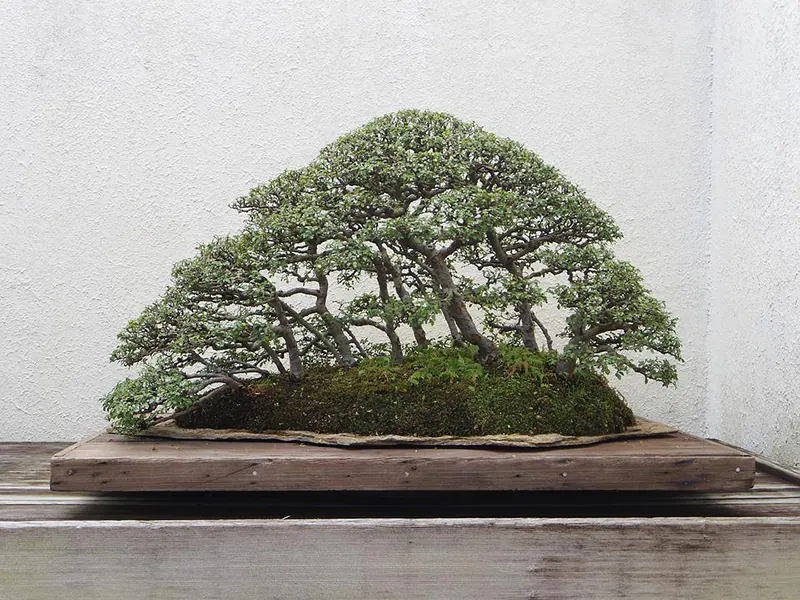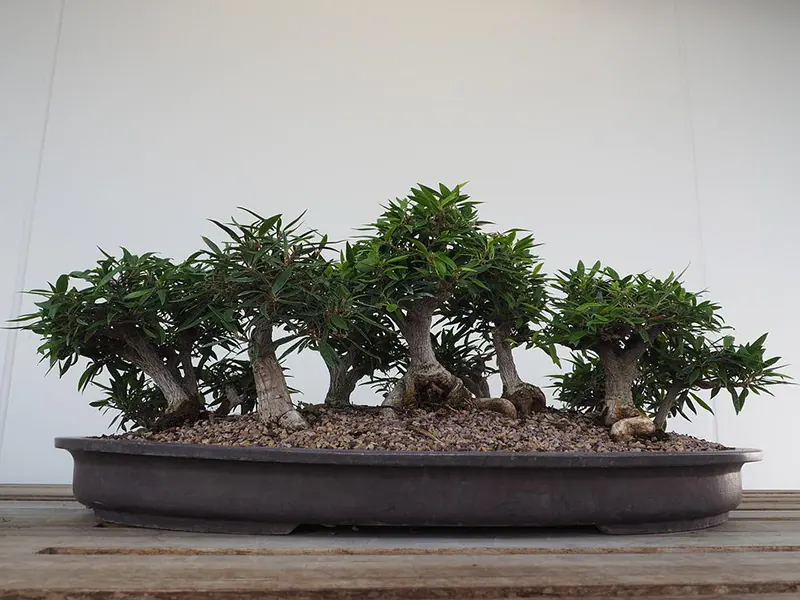Best Trees for a Bonsai Forest
A bonsai forest, Yose-ue, is just what it sounds like; several trees planted together in one container. Together these trees look like a miniature forest.
Most often, these forests consist of one species of tree, but there is no hard and fast rule, so several species can be used. Using more than one species can complicate the creation of the forest as the plants may have different requirements, so care should be taken to ensure the plants all have similar needs. Otherwise, you’re creating problems in caring for the forest.
A bonsai forest must not be confused with a Raft (Ikadabuki). In a Raft, the tree has fallen, and the original trunk is lying on the ground. The roots are still viable, and the tree grows one or more new “trunks,” which are, in reality, new branches from the original trunk. With training, each of the new “trunks” eventually looks like a new tree.
Some Basic Guidelines for A Forest
Bonsai is an art, not science (the science is how to grow trees, not create a picture), and while there are guidelines to help, the look and atmosphere created by a bonsai specimen is the creative mind of the grower at work.
Here are a few guidelines that will help you start your own bonsai forest.
- Few things in nature are even, so use an uneven number of trees, but if you intend to use more than 11 trees, using an odd number becomes irrelevant.
- Look for trees with varying trunk diameters. You need to look for one main tree that will be the focal point of your picture, then your other trees all play a supporting role.
- Select three focal trees. These will be placed first, then fill in with the other trees you have selected.
- Make sure that the tree’s height is proportionate to its trunk size.
- Don’t plant the trees in a straight line. Make sure that there is uneven spacing between the trees.

Trees to Use in Your Forest
Now that we have looked at some fundamental guidelines for placing trees, let’s look at the species that lend themselves to this type of planting.
Deciduous Trees
Many beautiful deciduous trees will look fantastic in a forest setting. During the warm months, they will sport stunning green foliage, which contrasts nicely with their trunks. Then as the weather cools, many will give you a flash of orange, red, yellow, and brown until they lose their leaves, and you can enjoy an intricate pattern of bare branches during the winter months.
- Beech – their characteristic pale-white bark, their lovely bright green foliage, and easy training make them ideal for this planting style. Their trunks take time to thicken, so the mature development of a pristine beech forest may take many years.
- Hornbeam – this is a deciduous tree that has pale grey bark, which complements the silvery white of the Beech. The trunk is short and twisted and will develop vertical markings and ridges with age.
- Elm – this is another excellent deciduous tree that will produce a beautiful forest. Bear in mind that some elms, such as the Chinese Elm, do develop crooked trunks, which may present a problem in your design, but can ad interest if the trunk bends out over the edge of the pot.
- Maple – these stunning trees need no introduction.
- Cherry – if you are building a mixed deciduous forest, adding a cherry tree can give that burst of color in spring.
- Birch – Th birch, with its pale, grey-white bark, is an excellent choice for your deciduous forest.
- Larch – this is a tall coniferous tree that is deciduous. Their trunks thicken quickly, making this an ideal main tree. They have lovely flaky bark, bear small cones, and have attractive yellow leaves in the fall. Their fine branches look beautiful in winter.

Evergreen Trees
Evergreen trees, mainly pines, and conifers, grow straight and tall, and not only do they have beautiful green foliage all year round, but they also often have a lovely smell. Many broadleaf evergreen trees make excellent bonsai forest specimens.
Broadleaf
- Serissa – this beautiful plant that bears tiny white flowers in spring and summer is also called the Snow Rose or Japanese Boxthorn.
- Azalea – these trees, with their magnificent flowers, make a bold statement when included in a forest.
- Acacia – these trees are also known as wattles. There are many species of acacia, and there are deciduous and evergreen varieties. The beautiful flat-topped acacias that occur naturally in Africa (Vachellia abyssinica) make a stunning forest with the flat tops at differing heights.
- Myrtle – these trees make lovely bonsai specimens with their delicate white flowers.
- Sweet Plum – this tree has beautiful shiny light green leaves and in the late summer bears yellow-white flowers followed by little blue fruits. The bark is brown but peels away in irregular patches, with the pale brown young bark showing. It gives the trunks an attractive sporty look.
- Firethorn – this beautiful tree with its bright green foliage and bright red berries is a good candidate for a forest. The tree is very forgiving and will bud quickly once pruned.
Pines and Conifers
- Juniper – this is one of the most popular bonsai trees and makes a fantastic forest. These trees are very forgiving and can be trained to almost any shape.
- Pines – these are one of the most popular bonsai specimens, and with their robust needles and straight trunks, they are an excellent choice for a forest.
- Spruce – these are not easy trees to manage in a bonsai environment as they do not quickly back bud, and their branches have the annoying habit of returning to their original position after wires are removed. Having said this, there are many outstanding examples of spruce bonsai, so it is worthwhile experimenting with them.
- Redwood – the Coast Redwood (from the USA) and the Dawn Redwood (from China) are wonderful bonsai trees. These trees grow straight, strong, and have lovely foliage. Both species produce small, round cones.
- Cedar – this magnificent tree, with its elegant foliage, makes an outstanding bonsai forest. They have attractive greyish-brown bark and bluish-green needles.

Final Thoughts
We have given you an extensive range of trees that you can use to create a forest. Again we would remind you that bonsai is an art and the creation in front of you is the result of your imagination. We have listed a few very basic rules you can use to get started, but this is your creation so do with it as you please.
We suggest that if this is your first forest, you start with a single species and tackle a multi-species tray only with some experience.
We would love to see any forests you create, so please leave us a picture in the comments below.






